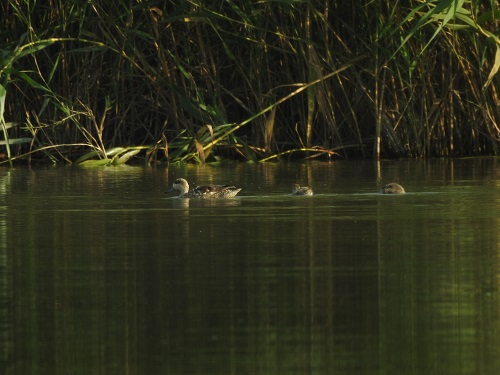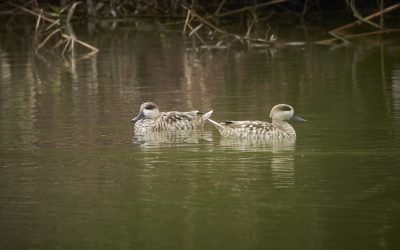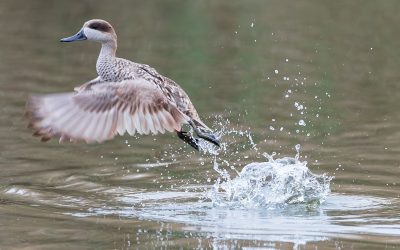Photograph by SEO/BirdLife.
The breeding season of the Marbled Teal during this year has provided so far three historical milestones that endorse the positive results that are being achieved in the LIFE Cerceta Pardilla project, ‘Coordinated actions for the recovery of the Marbled Teal (Marmaronetta angustirostris) in Spain’.
Although the global data of the breeding season will be compiled and published after the meeting of the Working Group of experts on the species, coordinated by MITECO, expected at the end of the year, three important milestones are already known in the project area, which covers key wetlands of the Natura 2000 Network.
The first reproduction recorded in the Region of Murcia for 15 years stands out, in the Laguna de las Moreras, in Mazarrón, where an adult female brown teal with 8 chicks was sighted in June. The sighting took place just a few hundred metres from where the regional government has carried out habitat improvement work within the framework of the project, and where the Asociación de Naturalistas del Sureste (ANSE) installed a pre-release cage. In this area, 47 specimens bred in captivity at the La Granja breeding centre in the Valencian Community have been released.
In addition, reproduction of the species has also been observed for the first time, with two broods of 5 and 8 chicks, in the Tancat de la Pipa, an Ornithological Reserve located in the Albufera de Valencia Natural Park, which is managed by SEO/BirdLife through a land stewardship agreement with the Júcar Hydrographic Confederation, owner of the reserve. A pre-release cage had been installed in the area in spring, from which 20 adult specimens were released.
In Andalusia, an exponential growth in breeding pairs and chicks was recorded in 2024 in the Paraje Natural del Río Guadalhorce and nearby areas, in Malaga, with 13 pairs and 102 chicks. Five of the breeding females have been identified: three were born in captivity in 2023 in the Cañada de los Pájaros (Seville) and were released this spring in the pre-release cage installed in the Guadalhorce. The other two females have been bred at the Zoobotánico de Jerez from eggs rescued in 2022. Both were released in November 2022, one of them in the Guadalhorce cage, but the other was released in Doñana, more than 170 km away. The species had not been known to breed in this wetland since 2004, when a pair bred, but in the spring of 2023 the presence of a female with chicks was detected. Since the end of 2022, 63 specimens from the captive breeding programme have been released in this area.
HABITAT IMPROVEMENT AND COORDINATION
Habitat loss and degradation is the greatest threat to marbled teal and endangers their survival. Wetlands are impacted by drought, pollution and the proliferation of artificial barriers and other problems caused by human activities. For this reason, the actions of LIFE Brown Teal are aimed at the restoration and continuous improvement of wetlands considered critical for the recovery of the species. To date, action has been taken on more than 2,300 hectares of the 3,000 hectares planned.
Fundamental to these actions are the land stewardship agreements and the agreements, eight of which have been signed within the framework of the project between public and private landowners and conservation organisations.
The importance of coordination between different actors is also highlighted by the effectiveness of the captive breeding programme, thanks to which 2,980 brown teals have been released to date within the scope of the LIFE project.
THE LIFE CERCETA PARDILLA PROJECT
LIFE Cerceta Pardilla aims to improve the conservation status of 3,000 hectares of wetlands to reverse the risk of extinction of Europe’s most endangered duck, which is in a critical situation in Spain. To this end, it has undertaken a series of actions to reinforce the state of its populations in the natural environment, improve the state of the wetlands and scientific knowledge of the species.
The project, which is coordinated by the Biodiversity Foundation of the Ministry for Ecological Transition and the Demographic Challenge, involves as partners the Ministry itself, through the Segura Hydrographic Confederation and Tragsatec; the Regional Government of Andalusia, through the Department of Sustainability and Environment, and the Environment and Water Agency M.P.; the Regional Government of Valencia; the Government of the Region of Murcia, as well as the organisations SEO/BirdLife and ANSE. It is supported by the LIFE Programme of the European Union and the Directorate General for Water.




